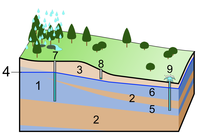
Photo from wikipedia
Abstract Lake Riogrande II, located in the central region of the Colombian Andes, has eutrophication due to a progressive increase of runoff pollution from upstream intensive dairy cattle and agricultural… Click to show full abstract
Abstract Lake Riogrande II, located in the central region of the Colombian Andes, has eutrophication due to a progressive increase of runoff pollution from upstream intensive dairy cattle and agricultural activities in the watershed. Public and private entities have invested in programs aimed at adopting the best agricultural management practices (BMP). BMP is a general formulation of recommended criteria and, therefore, not universally fit all problems. For example, the corrective measures taken so far demonstrate difficulties in selecting and allocating BMPs aligned to the space-time hydrological variability within the watershed. This research analyses the spatio-temporal dynamics of BMP pollution patterns. The study is built on the concept of critical source areas of runoff pollution from agricultural practices in the Colombia Andes. Fieldwork was conducted with the participation of farmers to collect spatial data of the current management operations for potato (Solanum tuberosum), tree tomato (Solanum betaceum), and dairy agriculture. A Soil Water Assessment model is used to simulate agricultural and hydrological processes. The model was calibrated using observed discharge, nitrate-N (NO3—N), and soluble phosphorus (P) concentrations at a monthly scale. The origin of pollution at the catchment scale was used applying the critical source areas (CSAs) method. This paper proposes for this analysis a new spatio-temporal CSA index (ST-CSA) to represent the behavior of the CSAs simultaneously in space and time. For this, several aggregated CSA in time were analyzed for monthly and annual time steps. Results indicate that there is an essential difference in the aggregation of CSA in time, and pollution location changes significantly using the ST-CSA. As expected, the highest number of CSAs occurs during the rainy months. However, these CSAs are located in the region with the lowest precipitation levels in the agricultural areas dominated by potato, tree tomato, and dairy agriculture located within the watershed. These areas vary significantly from 24.07% of the entire area of the basin (1034.348 km2), and it could reach a maximum value of 61.78%. Despite the model uncertainties, the results highlight the importance of identifying spatio-temporal CSAs to select BMPs with the highest potential of nitrogen and phosphorus losses reduction - such as the adaptation of fertilization schedules - applicable to the study watershed.
Journal Title: Ecological Engineering
Year Published: 2020
Link to full text (if available)
Share on Social Media: Sign Up to like & get
recommendations!